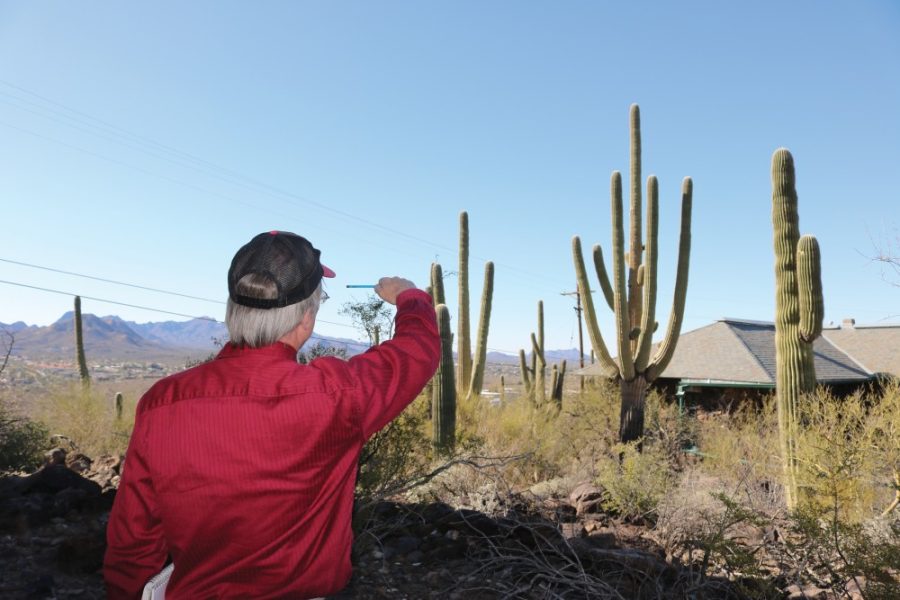A local landmark aims to merge the arts with the science in a collaboration from the Desert Laboratory on Tumamoc Hill and the University of Arizona’s Confluencenter for Creative Inquiry.
Tumamoc Hill, an 860-acre ecological preserve, is pairing art and science through the Tumamoc Transdisciplinary Arts Program, a project that aims to broaden the understanding to the public of what science-based research goes on at the hill.
This program opens up the hill for artists to engage with the desert and science community, according to Benjamin Wilder, Interim Director of Tumamoc Hill.
“The goal of this program is to really go back to the initial points of inspiration — how do we better communicate the results of research,” Wilder said. “We can tell the story in so many different ways and model ways to truly make all our users more appreciative of what a special site this is.”
Wilder said it’s important to think of the resources that the UA has that are not directly on campus. Places like Biosphere 2 and Tumamoc are both part of the university and offer assets to students and community members.
RELATED: UA department of East Asian Studies expands with new Korean minor
Wilder sees these places as opportunities to learn as well as be immersed in the culture that comes from these desert sites.
“I think it’s a great opportunity for students to be extended beyond campus and realize that this is still part of what it means to be a Wildcat,” Wilder said.
The art on Tumamoc started with Paul Mirocha, who has been an artist in residence for about six years. Prior to that. Wilder said there wasn’t much of an art presence on Tumamoc.
“The idea is to engage the people [who visit Tumamoc] with science and educate them,” Mirocha said. “It was something that was going to evolve and I was going to help it evolve.”
For the first few years, Mirocha was on Tumamoc by himself, doing a few projects, but then started inviting other artists to come up and do “a regular little drawing or outdoor painting sessions.”
This led to the creation of the Tumamoc Sketchbook, a blog showcasing the art created from the science on the hill.
Mirocha’s role with the Tumamoc Transdisciplinary Arts Program is that of an advisor while continuing to be an artist.
“I’ve become a resource to tap into when needed,” Mirocha said.
He has worked on multiple projects with Wilder and continues to play a role in the advancement of the program.
“[Mirocha] is a fantastic illustrator and has this beautiful way of capturing the kind of long-term patterns and the sense of the dessert and the region,” Wilder said.
The Tumamoc Transdisciplinary Arts Program is a collaboration with the Confluencenter for Creative Inquiry, a research center under the Office for Research, Discovery and Innovation at the UA that gave Tumamoc the funds to start the program.
For director of the Confluencenter, Javier Duran, there are three components that led to the Tumamoc Transdisciplinary Arts Program.
Duran is a frequent commuter to Tumamoc, and when seeing some of the early art it “cultivated a means to see what was going on there.”
This led to Duran meeting Wilder when he was appointed interim director. The two started talking about common interests and, with Wilder’s previous experience in art/science collaborations and the Confluencenter being active in promoting interdisciplinary projects, Duran was on board with helping fund the program.
“We began brainstorming about the possibility of creating a partnership that would help a group of artists play a more active part in the representation of Tumamoc,” Duran said. “With that conversation we created a plan and the Confluencenter awarded a fund for this to happen.”
For Wilder, the collaboration with the Confluencenter is something that helps create a link with the UA campus and is a “natural kind of partnership with them.”
The program also allows funding for a new arts fellow Lyn Hart, as well as new courses and smaller programs.
RELATED: CESL celebrates 50 years of ‘international culture’
“We’re creating an arts science course that is tailored towards scientists and biologists that is arming a scientist with a visual vocabulary,” Wilder said.
An indigenous perspective is another project the Tumamoc Transdisciplinary Arts Program is aiming to include, as well as a more academic approach to science and art at Tumamoc.
Science communication is something the program is directed toward — thinking about science in a different way and using different tools to communicate research and educate the public.
The Desert Laboratory of Tumamoc Hill has a four-week mini-course planned in May. It will be about two hours a week on Saturdays, discussing the behind-the-scenes of the program and science culture as well as the artistic perspective of communicating research to the community through art.
“We are excited to be a part of this, I see a lot of people in the community going [to Tumamoc] to do many different things but if people go and share experiences, you create a better community and a more diverse environment,” Duran said.
Wilder and other members of the program will meet Friday, March 2 at 11 a.m. at the Tumamoc buildings to explore the boundaries and opportunities the program will bring.
Wilder, Duran and Mirocha encourage the engagement of the community with the arts of Tumamoc as well as the learning opportunities it may bring.
“This is a great opportunity to see the connection between the arts and the sciences, but also to connect to the university, the community and the environment,” Duran said.
Follow Pascal Albright on Twitter















